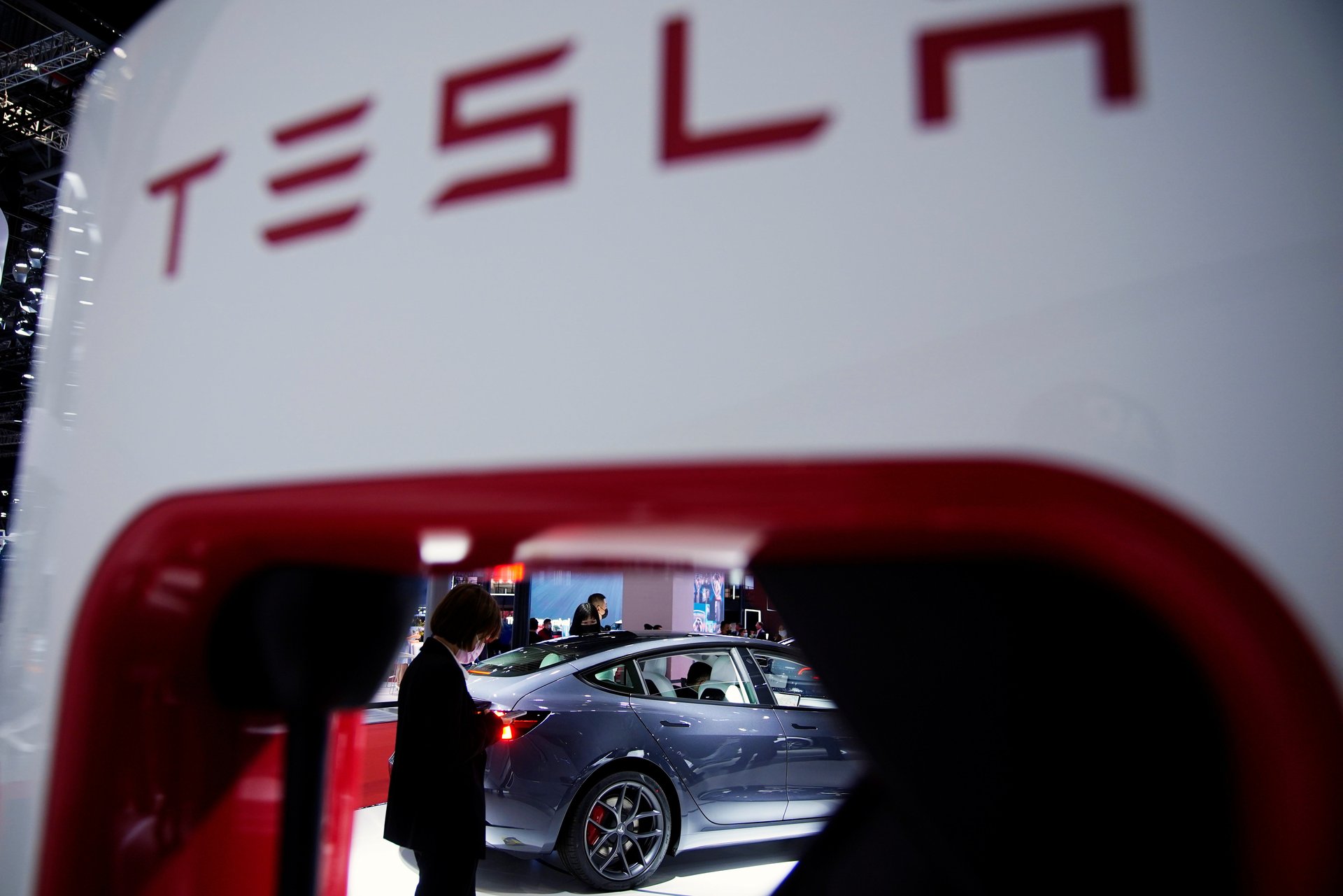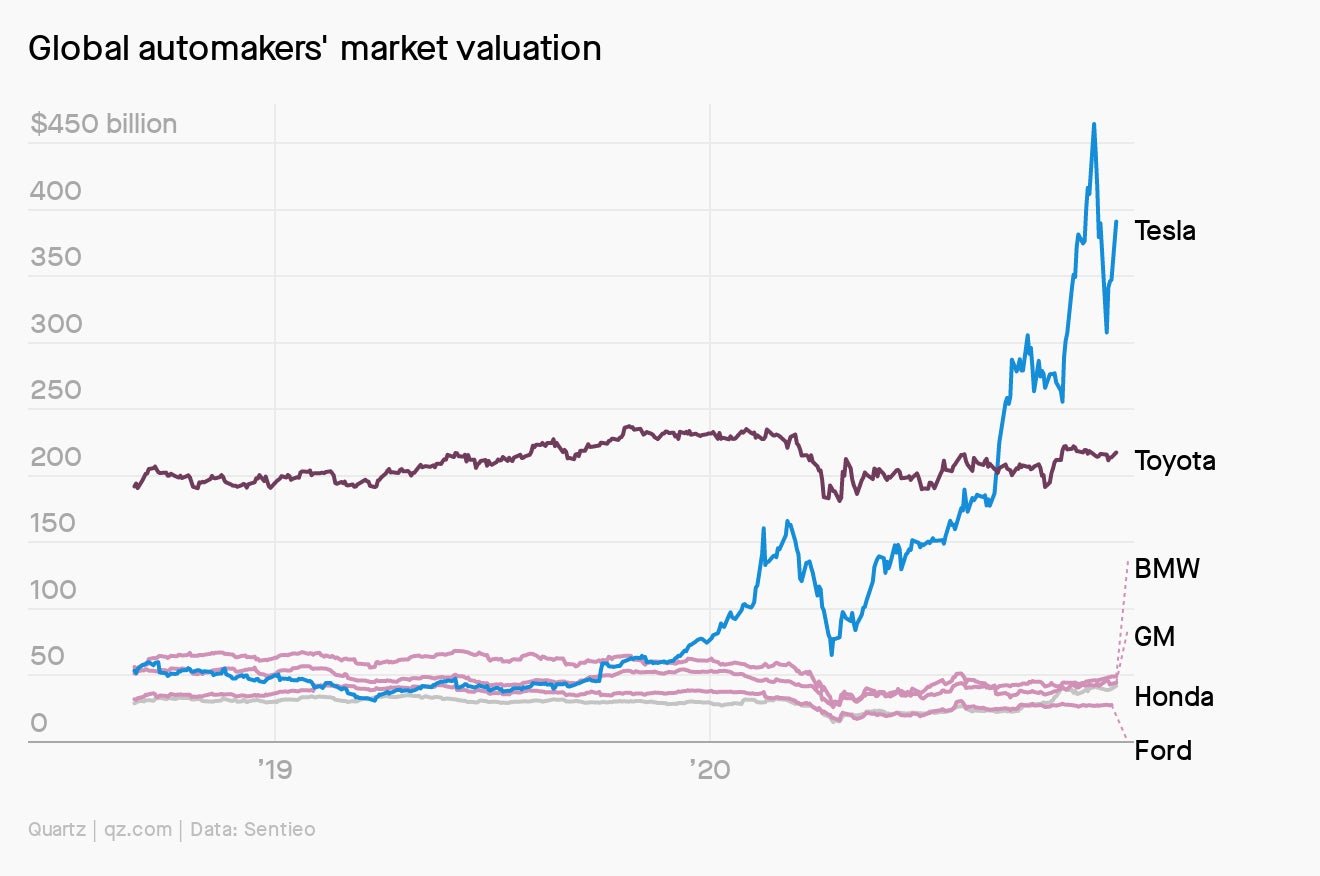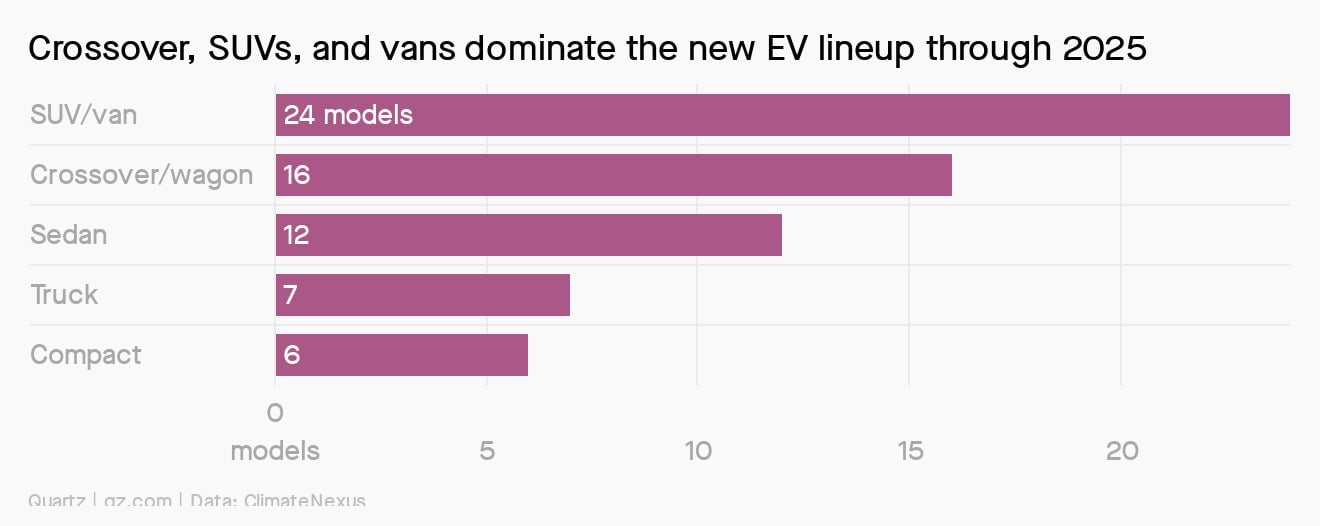For Quartz members—Tesla’s bump in the road
Hi [%first_name | Quartz member%],


Hi [%first_name | Quartz member%],
It wasn’t that long ago nobody wanted an electric car. In 2003, GM claimed “limited demand” as the reason for crushing (literally) its EV1 model. But the Detroit automaker should have specified: It couldn’t be bothered to sell its electric car. Tesla, after selling more than 1 million electric vehicles globally and seizing the title of world’s most valuable automaker, is rewriting the rules of the road.
But first, a recap: Microsoft dodged a bullet by losing its TikTok bid, California’s wildfires are producing more CO2 than power plants, and China’s micro-aggressions against Taiwan have reached the world of birding. A massive software IPO signaled the future of AI, and Europe and China agreed to recognize each other’s beverage expertise. Halloween is a month away, but the ghost of Milton Friedman is always around.
Your most-read story this week: A mental health crisis is brewing among South Asian immigrants in the West. And most relatable member goes to everyone making use of the 🎉 new feature 🎉 that lets you unlock and share paywalled stories. We can all relate to learning something new and wanting to tell someone else about it ASAP.
Okay, buckle your seatbelt and activate self-driving mode. We’re taking Tesla for a spin.
The S&P swipes left
It was supposed to be Tesla’s coronation. After narrowly escaping bankruptcy, the Silicon Valley automaker—profitable and dominant in an industry that once dismissed it—was to enter the S&P 500 index on Sept. 4. To sweeten the symbolism, oil and gas giant ExxonMobil had just been ejected from the Dow Jones index, marking the fossil fuel industry’s ignominious decline during the energy transition.
Only Tesla didn’t make the cut. Despite four profitable quarters and a market cap exceeding $400 billion, it wasn’t enough. The company’s share price plummeted by a third following the bad news. Tesla’s unexpected slight may have had something to do with the composition of its financials: Its $368 million in profits over the last four quarters was eclipsed by $1.05 billion in sales of regulatory credits to other carmakers for zero-emission vehicles.
True to form, however, Tesla’s exclusion from the S&P 500 barely dented the carmaker’s momentum. It has regained more than half its losses since being passed over for the index, and has lined up plenty of good news to keep investors interested. A pickup, heavy-duty semi, Roadster sports car, and battle-ready Cybertruck are on the way. Tesla is making plans to enter the German energy market. And Tesla’s vehicles—the Models S, 3, X, Y lineup—are selling well despite the pandemic.
In fact, Covid-19 has changed little about the automaker’s plans, Musk said on an earnings call in April: “We came to the conclusion that the right [path] was actually to continue to expand rapidly, continue to invest in the future in new technologies, even though it is risky.” It seems ludicrous mode is not just a setting for Tesla’s cars.

A wild ride
Tesla’s stock quadrupled this year, allowing the company to raise an astounding $7.3 billion in 2020. In August, investment bank RBC told investors Tesla is “fundamentally overvalued,” echoing widespread sentiment on Wall Street.
For Tesla’s stratospheric share price to make sense, it argued, the carmaker must grow more than 30% per year for the next decade. And the comparable companies to pull off such a feat—Apple, Amazon, and Google—don’t operate under the auto industry’s razor-thin margins.
Yet nothing seems to dent investors’ faith in Musk, whose (mis)behavior as head of the company’s board has made him “effectively uninsurable.” And the showman always has more pyrotechnics for his fans: new autopilot features, expanding factories in Berlin and Shanghai, a million-mile battery, and who knows what’s next.
Maybe that’s the point. Musk has never contested that Tesla’s bumpy road to today’s stock price doesn’t justify its valuation. “Tesla is absurdly overvalued if based on the past, but that’s irrelevant,” Musk tweeted in 2017 when its valuation was a mere $70 billion. “A stock price represents risk-adjusted future cash flows.” And he knows investors are betting on a very, very bright future.

Correcting cobalt
EVs’ batteries rely on a variety of metals and minerals—cobalt, nickel, lithium, and more—most often sourced from mines in developing countries that are rife with instances of child labor, corruption, toxic pollution, and deforestation. Tesla is no exception. Musk said in 2018 that he would prefer to ditch cobalt altogether, but current battery design makes that difficult. In the meantime, he’s shopping for better sources: Last week the company joined an alliance to support improved cobalt-mining practices in the Democratic Republic of the Congo. It’s also in talks to buy low-carbon-footprint nickel from a specialized mine in Canada.
Good energy
Since Henry Ford’s first black Model T rolled off the assembly line in 1908, automakers have been building gasoline cars and trucks along roughly the same lines. Tesla was the first and only firm to envision itself as an energy company. As Musk wrote in his “Secret Tesla Motors Master Plan” in 2006, Tesla would “help expedite the move from a mine-and-burn hydrocarbon economy towards a solar electric economy.”
Since then, Tesla has ventured into batteries, solar panels, self-driving software, photovoltaic roof tiles, underground transportation (via The Boring Company), and even interplanetary travel. Musk hurled a Model 3 toward Mars aboard his SpaceX Falcon Heavy rocket in 2018.
Some of those ambitions have nearly bankrupted the company more than once. But they might also pay off. And Musk has never wavered much from the “master plan” he laid out more than a decade ago:
- Build sports car
- Use that money to build an affordable car
- Use that money to build an even more affordable car
- While doing above, also provide zero-emission electric power generation options
- Don’t tell anyone.
Automotive influencers
Tesla relies on people like Will Fealey. President of the Tesla Owners Club UK, Fealey and his fellow club members spend their spare weekends at car shows, offering “10,000 test drives” to prospective Tesla owners. “Staff from companies like Pagani, Aston Martin, BMW, and Porsche had to pick up their jaws from the floor once they realized we were volunteers from the official UK owners club and not employed by Tesla,” he tweeted.
No other car company can claim this, because Tesla isn’t like other car companies. It spends virtually $0 on paid advertisements. Ford spends roughly $2,000 per sale for its Lincoln line. Even luxury heavyweights like BMW pony up about $200 apiece to move cars off the lot.
That’s a durable competitive advantage, but Tesla still faces huge headwinds. It’s a new, relatively small automaker in a cutthroat market where EVs make up just 2.6% of global sales. Tesla’s zero-emission credit sales, rather than margins on vehicle sales, represent all of its profits and more. Next year, more than 30 new EV models from rival carmakers will hit the market, a “watershed year” for EVs, says Herbert Diess, Volkswagen’s CEO.

But when you have an army of customers ready to sell your car, maybe you’re doing something right.
Keep reading
- Tesla’s Cybertruck is ridiculous, but who wants to bet against Elon Musk?
- We’re about to enter a world where Tesla is the cheaper electric car
- Tesla’s success during the coronavirus crisis, in charts
- Electric cars got crushed in 2020, but next year could be their best
- The world’s best known short seller says Tesla traders are feeding on testosterone
- The past, present, and future of electric vehicles
- Electric cars are changing the cost of driving
Thanks for reading! And don’t hesitate to reach out with comments, questions, or companies you want to know more about.
Best wishes for an accelerated end to your week,